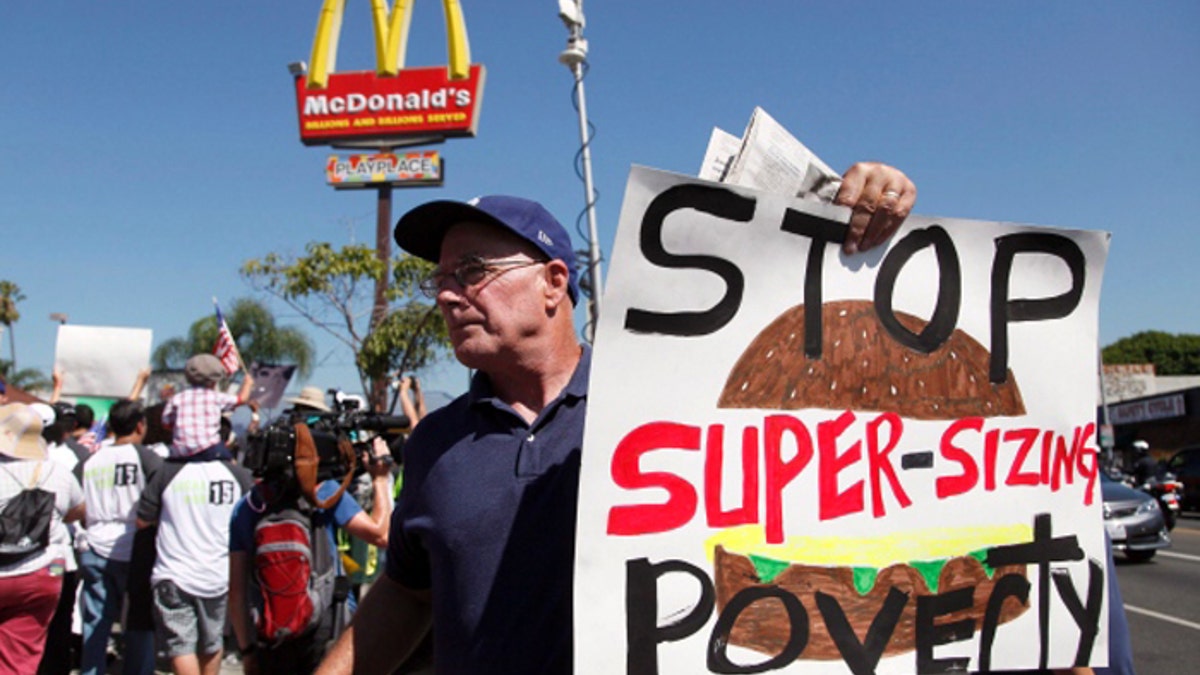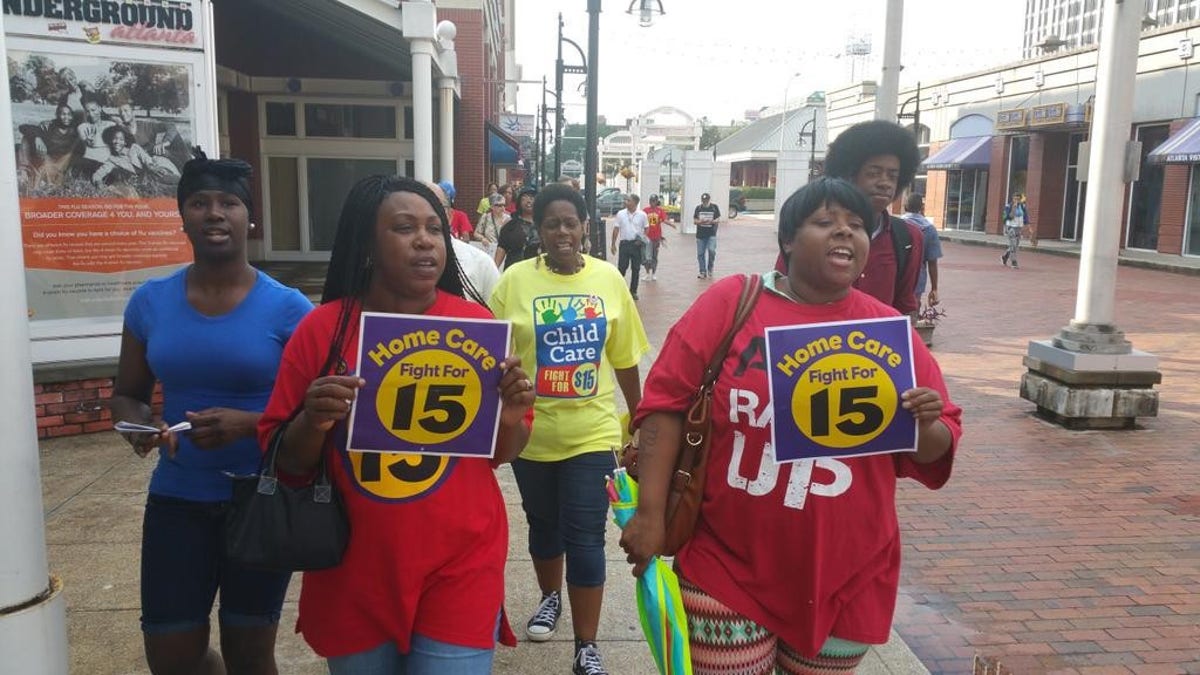
Much of the SEIU spinoff campaign's fight has been waged against fast-food giant McDonald's. (AP)
One of America’s biggest labor unions is spending millions in a bid to make billions, using protests, public relations and political muscle in a bid to super-size its rank and file with fast-food workers.
The Service Employees International Union, whose 1.9 million members already include thousands of food service workers, as well as healthcare workers, janitors, security guards and local and state government employees, has spent an estimated $80 million over the last three years on an elaborate plan to capture the loyalty - and dues - of fast food workers.
“We know by now that fast food workers aren't making enough to survive,” the SEIU states in an online appeal to fast-food workers and supporters of higher wages for them. “And our economy can't thrive if so many people are being held back.
“The SEIU is sponsoring ‘Fight for 15’ to do its dirty work.”
Organizing just a third of the nation’s estimated 3.6 million fast-food workers could bring in more than $400 million per year in dues, according to one estimate, making the SEIU’s commitment to the cause no mystery.
At the center of the SEIU bid to organize the cooks, cashiers and cleaners who toil at the nation’s estimated 160,000 fast-food restaurants is the “Fight for 15” movement. Portrayed in some quarters as a grassroots initiative comprised of struggling fast food workers and activists, it is coordinated by SEIU Deputy Chief of Staff Scott Courtney. The effort appears designed to have the same effect as a massive organization drive, with the focus on an entire industry as opposed to a single employer, say labor experts.
“The SEIU is sponsoring ‘Fight for 15’ to do its dirty work,” Jared Meyer, a fellow at the Manhattan Institute for Public Policy Research, told FoxNews.com.
SEIU’s costly campaign involves everything from publicity-yielding strikes and street protests to supporting lawsuits over alleged unpaid wages and discriminatory terminations to put pressure on fast food owners and management to accept unionization and raise pay. The union has been widely accused of sending members from other industries to swell the ranks of fast-food protesters.

Workers in New York declared victory this summer, when Gov. Andrew Cuomo announced a plan to raise the state minimum wage to $15. (Fight for15.org)
Skeptics say union bosses like Courtney, who earns more than $220,000 per year, see fast-food workers not simply as exploited employees but as a means of replenishing dwindling dues revenue.
“Most union bosses are more concerned with their own interests and those of retirees than with providing value for new members,” Meyer said.
In addition to labor protests, the SEIU effort includes slick public relations and high-powered legal efforts. According to the Employment Policies Institute, the union shelled out millions over the last three years to hire powerful public relation firm Berlin Rosen, which helped engineer the election of New York City Mayor Bill de Blasio in 2013.
Last year, the SEIU score a major victory against McDonald’s that experts said will have major consequences for the fast-food franchise model when the National Labor Relations Board ruled that the corporation can be held liable for labor violations committed at independently-owned franchises.
The decision was seen as opening the door for unions to organize simultaneously across the corporation, rather than through individual drives at the thousands of companies that own one or more franchises.
“A group of unelected Washington Bureaucrats has ganged up with union bosses,” said Robert Cresanti, vice president of the International Franchising Association.
McDonald’s Corp. officials did not respond to requests for comment, but have so far refused to negotiate with the SEIU or the Fight for $15 orchestrators. The corporation, which owns and operated about 20 percent of its stores, this year raised wages to at least $1 more than the federal minimum wage of $7.25 or the local minimum wage, whichever is higher.
Neither the SEIU nor its “Fight for $15” campaign responded to requests for comment, but Courtney has been vocal about his plan to establish a large, nationwide organization of low-wage workers to constantly demand that companies and lawmakers better wages and working conditions.
“It’s the first really workers’ movement that has captured the country’s imagination in my lifetime,” he recently told The Guardian. “This campaign has dramatically changed the conversation about wages. It’s created a different conversation about what it takes people to live on. Fifteen dollars has become a new rallying cry.”
Victory in the nation's biggest city came in July, when New York Gov. Andrew Cuomo announced plans to raise the state minimum wage, now $8.75 an hour, to $15 in New York City by 2018, and statewide by 2021.
The fast food industry has long been coveted for unionization, but it has so far fought off attempts. Experts say organization efforts have stumbled in part because of the trade’s high-turnover rate and reliance on young and part-time workers who do not see much value in return for paying union dues. A vast majority of fast-food workers also do not see their current jobs as a full-time career, in contrast to workers in other industries such as manufacturing or education, say experts.
But the U.S. Department of Labor and President Obama have been staunch advocates for hiking the minimum wage across the country, with Obama appointee Mary Beth Maxwell – principal deputy assistant secretary for policy in the Department of Labor – praising the “Fight for $15” campaign on the official website. The support works both ways: The SEIU, a prominent Democratic Party donor, gave more than $60 million to Obama’s 2008 campaign and in direct donations and so-called soft money contributions.
In August, the Democratic National Committee formally adopted the $15 minimum wage into its political platform, following in the steps of several entities such as New York state, as well as cities including Los Angeles, San Francisco, Seattle, Chicago and Kansas City which have already passed legislature to bump up existing minimums.
Meyer believes a unionized fast food industry will ultimately result in a reduction of jobs, as higher labor costs force fast-food restaurant owners to turn to automation - several have installed touch-screen kiosks for placing orders - or even close their doors. But he believes the SEIU and other labor unions could succeed in the “not too distant future” in capturing the massive army of workers who serve up sandwiches.
“This is great news for unions,” he said. “But terrible news for young workers.”





















